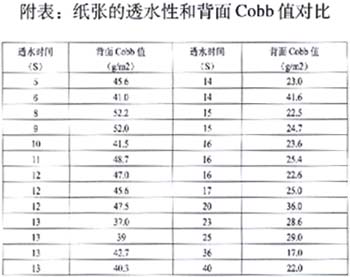With the continuous improvement of production automation, the labeling speed of bottled beer and beverages has become faster and faster, and the quality requirements for trademarks have become higher and higher. In the printing process of trademarks, the user feedback we often encounter is posted. There are wrinkles and breakage problems in the standard process.
Normally, our printing of trademark paper is basically one-sided coated paper. There is a set of strict rules and complete testing methods for the entry of raw materials into the factory, and we strictly follow the GB/T100335-1995 single-sided coated paper product quality standards for testing and determination. However, they often receive feedback on the above quality issues. After the analysis of the reasons for breaking the mark, wrinkle mark: First, the paper's back surface water absorption value is too large; Second, the transverse stretch rate of the paper is too large. The indicators specified in GB/T 100335-1995 are quantitative, quantitative, whiteness, opacity, glossiness, glossiness of printing, strength of printed surface, smoothness, ink absorption, dustiness, and delivery moisture. These indicators are basically for the printing of paper, that is, these indicators basically ensure the printability and print quality of the paper. However, there is no specific index control over the label's attainability. So we added the paper's back Cobb value and lateral stretch rate based on the original inspection index, and also communicated with users to control the amount of water in the adhesive. These methods reduce the number of customer complaints, but they do not fundamentally solve quality problems.
Users generally use water-soluble glue in the labeling process, and the speed is generally controlled at about 500 bottles/minute. It can be said that the brand will produce bottles and bottles (trademarks and trademarks) within a few seconds after being affixed to the bottles. In the collision, the adhesive is still wet, and the slow-permeable trademark absorbs glue on the back side, and the front surface is still dry. The paper fiber stiffness and the binding strength between the fibers are less damaged, so the trademark is quite firm. It is not easy to wrinkle and break; the fast-flowing brand quickly penetrates into the front after absorbing the glue on the back, and the paper fiber stiffness and the binding force between the fibers are drastically reduced, resulting in the trademark being too soft, easy to wrinkle, and easily damaged, resulting in breakage. The standard is very easy to appear. After repeated tests, the labeling test determined that the water permeation speed of the paper is a key factor in controlling the damage and wrinkling of the trademark during the labeling process.
After observing the brewery-production line, it was found that the main stage of breaking the mark was within ten seconds after the wine label had been attached to the bottle. Ten seconds later, with the drying of the glue, there was basically no breakage. In other words, the brand's oozing time of more than 10 seconds can satisfy the trademark applicability.
The performance index of the paper before and after printing is inconsistent. After the printing test and inspection, it is concluded that the water permeation time of the paper after printing is reduced by about 3 seconds. It can also be explained as if the trademark's permeation time requirement is greater than 10 seconds. The paper's permeable time must be controlled for more than 13 seconds. According to this index, the acceptance of qualified papers, after the production was put into operation, no signs of trademark wrinkling or labelling were found.
The paper's back Cobb value and lateral stretch rate cannot control the logo's wrinkling and breakage due to:
Although the Cobb value and the permeable time all reflect the sizing degree of the paper, the main factor affecting the Cobb value is the surface coating of the paper, and the main factor affecting the permeation time is the internal sizing of the paper.
The Cobb value of the paper detects the amount of water absorbed in one minute (this water absorption may have reached saturation in half a minute), and the time it takes to detect the paper's water absorption speed is not measured.
In general, the greater the water absorption value of the back of the paper, the faster the water permeability, but the relationship between the two is not proportional. And the paper of different manufacturers, the ratio of the two is not the same;

The main reason for breaking marks and wrinkles is the loss of fiber stiffness and binding force. The transverse stretch rate of paper is generally controlled below 3%, and as long as the water permeability is good and the stiffness is good, it will not cause trademark wrinkling.
Source: Food Industry Forum
Our Aluminum Fence product line is fabricated from 6063 series aluminum alloy material. Aluminum is a lightweight metal with impressive strength.The post is aluminum and has a powder coat finish to match the fence. This makes our residential aluminum fence perfect for installations around pools and other wet areas Aluminum Fence is a mature and proven fence system that is the modern alternative to wood, PVC or WPC. It combines the style, privacy and aesthetics of wood with the technology and durability of aluminum and fireproof.
Fence Post & Pedestal,Aluminum Metal Fence Post,Fence Post Wood,Wood Fence Post
FOSHAN GD ALUMINUM CO LTD , https://www.gd-fence.com